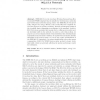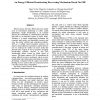20 search results - page 2 / 4 » Reducing Collision Probability in Wireless Sensor Network Ba... |
INFOCOM
2006
IEEE
13 years 10 months ago
2006
IEEE
— We present in this work a new mechanism based on an innovative hybrid approach for traffic and collision control in wireless ad hoc networks. We combine the well known equatio...
GLOBECOM
2006
IEEE
13 years 11 months ago
2006
IEEE
— IEEE 802.11 DCF exhibits poor scalability due to the large contention overhead. Therefore, the more the number of stations, the less the aggregate throughput. We propose a two-...
ICOIN
2007
Springer
13 years 11 months ago
2007
Springer
Abstract. IEEE 802.15.4 is the Low-Rate Wireless Personal Area Network (LR-WPAN) standard that is suitable for wireless sensor networks and wireless home networks among others. The...
GLOBECOM
2010
IEEE
13 years 2 months ago
2010
IEEE
Energy efficiency is one of the crucial design criteria for wireless sensor networks. Idle listening constitutes a major part of energy waste, and thus solutions such as duty cycli...
MUE
2007
IEEE
13 years 11 months ago
2007
IEEE
Wireless Sensor Networks (WSNs) have been widely used in environment monitoring to collect useful information. Packet broadcasting is an essential function for establishing a comm...


